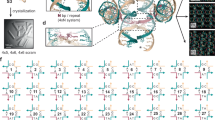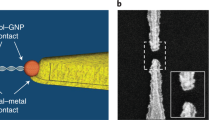Abstract
Structural DNA nanotechnology finds applications in numerous areas, but the construction of objects, 2D and 3D crystalline lattices and devices is prominent among them. Each of these components has been developed individually, and most of them have been combined in pairs. However, to date there are no reports of independent devices contained within 3D crystals. Here we report a three-state 3D device whereby we change the colour of the crystals by diffusing strands that contain dyes in or out of the crystals through the mother-liquor component of the system. Each colouring strand is designed to pair with an extended triangle strand by Watson–Crick base pairing. The arm that contains the dyes is quite flexible, but it is possible to establish the presence of the duplex proximal to the triangle by X-ray crystallography. We modelled the transition between the red and blue states through a simple kinetic model.
This is a preview of subscription content, access via your institution
Access options
Access Nature and 54 other Nature Portfolio journals
Get Nature+, our best-value online-access subscription
$29.99 / 30 days
cancel any time
Subscribe to this journal
Receive 12 print issues and online access
$259.00 per year
only $21.58 per issue
Buy this article
- Purchase on Springer Link
- Instant access to full article PDF
Prices may be subject to local taxes which are calculated during checkout




Similar content being viewed by others
References
Seeman, N. C. Nucleic acid junctions and lattices. J. Theor. Biol. 99, 237–247 (1982).
Seeman, N. C. From genes to machines: DNA nanomechanical devices. Trends Biochem. Sci. 30, 119–125 (2005).
Zheng, J. et al. From molecular to macroscopic via the rational design of a self-assembled 3D DNA crystal. Nature 461, 74–77 (2009).
Wang, T. et al. A DNA crystal designed to contain two molecules per asymmetric unit. J. Am. Chem. Soc. 132, 15471–15473 (2010).
Nguyen, N. et al. The absence of tertiary interactions in a self-assembled DNA crystal structure. J. Mol. Recognit. 25, 234–237 (2012).
Sha, R. et al. Self-assembled DNA crystals: the impact on resolution of 5′-phosphates and the DNA source. Nano Lett. 13, 793–797 (2013).
Mao, C., Sun, W., Shen, Z. & Seeman, N. C. A DNA nanomechanical device based on the B–Z transition. Nature 397, 144–146 (1999).
Yan, H., Zhang, X., Shen, Z. & Seeman, N. C. A robust DNA mechanical device controlled by hybridization topology. Nature 415, 62–65 (2002).
Sherman, W. B. & Seeman, N. C. A precisely controlled DNA bipedal walking device. Nano Lett. 4, 1203–1207 (2004).
Omabegho, T., Sha, R. & Seeman, N. C. A bipedal DNA Brownian motor with coordinated legs. Science 324, 67–71 (2009).
Chakraborty, B., Sha, R. & Seeman, N. C. A DNA-based nanomechanical device with three robust states. Proc. Natl Acad. Sci. USA 105, 17245–17249 (2008).
Rothemund, P. W. K. Folding DNA to create nanoscale shapes and patterns. Nature 440, 297–302 (2006).
Gu, H., Chao, J., Xiao, S. J. & Seeman, N. C. Dynamic patterning programmed by DNA tiles captured on a DNA origami substrate. Nat. Nanotech. 4, 245–249 (2009).
Gu, H., Chao, J., Xiao, S. J. & Seeman, N. C. A proximity-based programmable DNA nanoscale assembly line. Nature 465, 202–205 (2010).
Ding, B. & Seeman, N. C. Operation of a DNA robot arm inserted into a 2D DNA crystalline substrate. Science 314, 1583–1585 (2006).
Yurke, B., Turberfield, A. J., Mills, A. P. Jr, Simmel, F. C. & Newmann, J. L. A DNA-fuelled molecular machine made of DNA. Nature 406, 605–608 (2000).
Zhang, D. Y. & Winfree, E. Control of DNA strand displacement kinetics using toehold exchange. J. Am. Chem. Soc. 131, 17303–17314 (2009).
Seeman, N. C. De novo design of sequences for nucleic acid structure engineering. J. Biomol. Struct. Dyn. 8, 573–581 (1990).
Otwinowski, Z. & Minor, W. Processing of X-ray diffraction data collected in oscillation mode. Methods Enzymol. 276, 307–326 (1997).
Emsley, P. & Cowtan, K. COOT: model-building tools for molecular graphics. Acta Cryst. D 60, 2126–2132 (2004).
Adams, P. D. et al. PHENIX: building new software for automated crystallographic structure determination. Acta Cryst. D 58, 1948–1954 (2002).
Acknowledgements
We thank P. Chaikin for the use of his confocal microscope. This research was supported by the following grants to N.C.S.: GM-29554 from National Institute of General Medical Sciences, grants CMMI-1120890, EFRI-1332411, CCF-1117210 and CCF-1526650 from the National Science Foundation, MURI W911NF-11-1-0024 from the Army Research Office, MURI N000140911118 from Office of Naval Research, DE-SC0007991 from the US Department of Energy (DOE) for DNA synthesis and partial salary support, and grant GBMF3849 from the Gordon and Betty Moore Foundation. Beam line X29 of the BNL-NSLS, which is supported principally from the Offices of Biological and Environmental Research and of Basic Energy Sciences of the US DOE and from the National Center for Research Resources of the National Institutes of Health.
Author information
Authors and Affiliations
Contributions
Y.H., M.K., C.H., J.J.B. and R.S. performed the experiments, and all of the authors analysed data and wrote the manuscript.
Corresponding author
Ethics declarations
Competing interests
The authors declare no competing financial interests.
Supplementary information
Supplementary information
Supplementary information (PDF 4397 kb)
Supplementary Movie
Supplementary Movie 1 (AVI 1027 kb)
Supplementary Movie
Supplementary Movie 2 (AVI 2423 kb)
Rights and permissions
About this article
Cite this article
Hao, Y., Kristiansen, M., Sha, R. et al. A device that operates within a self-assembled 3D DNA crystal. Nature Chem 9, 824–827 (2017). https://doi.org/10.1038/nchem.2745
Received:
Accepted:
Published:
Issue Date:
DOI: https://doi.org/10.1038/nchem.2745
This article is cited by
-
The influence of Holliday junction sequence and dynamics on DNA crystal self-assembly
Nature Communications (2022)
-
Ordered three-dimensional nanomaterials using DNA-prescribed and valence-controlled material voxels
Nature Materials (2020)
-
Complex assemblies and crystals guided by DNA
Nature Materials (2020)
-
DNA nanotechnology
Nature Reviews Materials (2017)



